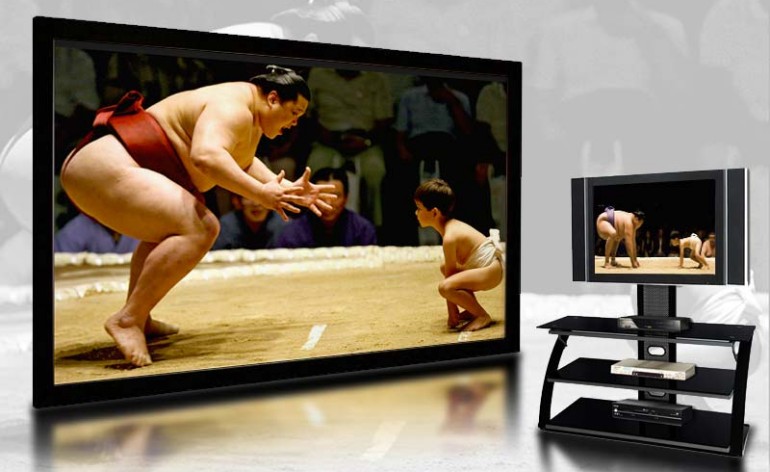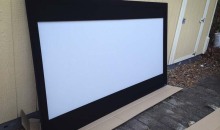Using a Projector for Home Theater
You can’t get a bigger screen for less money than by using front projector for home theater. There, I said it. No matter how far the costs for flat panel TVs fall, the price of using a projector for home theater is keeping pace. That means that when you pick up a projector, you’re in the position to have a screen size of over 100-inches starting at around $999—and that includes the screen. Of course, you can pay more for your home theater projector system, but it’s good to know that you can dazzle your friends (not to mention yourself) for under a grand if you don’t have a lot to invest.
Advantages of Using a Projector for Home Theater
Screen Size and Immersion
Aside from the sheer size of the screen, you can really get immersed in the story with using a projector for home theater. After all, nobody pays $10-$12 to sit in a movie theater and watch a 60-inch flat panel television! A larger screen will take you out of reality and place you more quickly into the action. You’ll become more a part of the action on the screen and, as a result, your satisfaction level for movies and dramatic television will soar.
Locating Speakers Behind the Screen
Using a projector for home theater lets you do something with your speakers that you can’t accomplish with a flat panel—namely, placing them behind the screen. While this isn’t always possible, a perforated projection screen allows you to place the speakers behind the screen material. They are specially designed to produce a great picture while allowing sound to pass through unmolested (at least, not significantly so). This is how commercial theaters operate and it has the added benefit of enuring that on-screen action comes from the screen. When there’s on-screen dialogue, it truly comes from the person you’re watching. This can be simulated with stereo speakers to great effect, but there’s no beating an authentic source located directly behind the action.
Hiding Gear
When you run a front projection system, your video cabling needs to run to the back of the room. A lot of times that means you can also relocate your other equipment away from the front of the room, leaving a nice clean aesthetic for your theater or living space. Combining this with electric drop screens, or simply constructing a well-balanced theater room, you can really achieve a nice look that’s often more difficult with a traditional flat panel display-based system.
Disadvantages of Using a Projector for Home Theater
Daytime Viewing
Watching television shows and movies when the sun is out may prove troublesome for many projection systems. Of course, having the sun shining directly on your flat panel TV will give you no joy either. Still, projectors cannot “project” black. Black is represented by the darkest you can get your screen and is largely “simulated” by the overall contrast of the system. That’s right, the depth of the “black” levels you see in a film projected onto a white screen are completely up to how much light control you can provide in the room. For some time I’ve recommended making sure you can control the light in any room in which you want to be able to watch films. It will help your overall enjoyment of the film and it will allow you to get better contrast (deeper blacks and brighter white levels).
Locating Your Equipment
While it’s true (as I said above) that you can really get a clean look with using a projector for home theater, it’s also true that it won’t be as easy as setting up a TV on a stand and connecting your other gear. You may need to run a video cable into your attic to reach the projector from the ceiling and you may also need to run that video cable back to the front of your room if your gear has to be located there.
Projector Bulb Life
It’s getting so that projector bulb life isn’t a terrible issue for most people. When LED lamps take over this will be an even lesser issue. For now, however, projector bulbs can last anywhere from 2500-6000 hours depending upon the model you purchase. That’s a far cry from the tens of thousands of hours you can expect from an LED backlit television. Keep that in mind, but don’t let it keep you from your purchase. Remember, you’re getting a gigantic screen size in exchange for the short lamp life. And projector lamps are separate from the rest of the projector’s subsystems. This means that when you replace the lamp you shouldn’t be throwing anything else out of whack.
Your Friends Will All Want to Live at Your House!
This goes without saying, but when you use a true projector for home theater, you just made yourself the new “hangout”. Don’t expect to watch too many movies without company. Friends will just “drop by” to what’s going on…at around prime time before their favorite show. And forget about going anywhere else for the Super Bowl. You won’t want to watch it on anything less than your gigantor screen, and neither will your friends once thy’ve experienced it larger than life. You’ll even start getting nicknames for your theater and at least one of your friends will probably tag your location on Facebook so everyone else will know where to go for weekly movie night events…And, yes, I’m speaking from experience.
Did we forget anything in this article? If so, leave a comment below to let us know.






